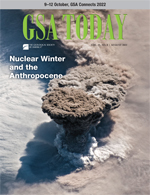Abstract View
Volume 32 Issue 8 (August 2022)
GSA Today
Article, p. 4-9 | Full
Text
| PDF
Nuclear Winter and the Anthropocene
Jon Spencer
Dept. of Geosciences, University of Arizona, Tucson, Arizona 85721, USA, Spencer7@arizona.edu
Abstract
In 2019, the Anthropocene Working Group proposed the creation of an Anthropocene
chronostratigraphic time unit to follow the Holocene Epoch. The Anthropocene time period would
begin in the mid-twentieth century, coincident with rapid acceleration of multiple, ongoing
anthropogenic changes to Earth’s surface and environments. Radioactive isotopes dispersed during
the 1952–1962 period of atmospheric thermonuclear-bomb tests form a proposed global marker for
the beginning of the Anthropocene. This marker is proposed for purely geological reasons as it
is reasonably precise and global in scope. These isotopes are also a marker for the initiation
of a new human capacity to trigger global environmental change in a period of hours. The
possibility of a global, multi-year nuclear winter following a nuclear war between North
Atlantic Treaty Organization nations and Russia is suggested by recent studies of wildfires that
injected sunlight-blocking smoke into the stratosphere, and by increasingly sophisticated
numerical simulations of global climate following a major nuclear war. Although the proposal for
an Anthropocene time period was made without consideration of the consequences of nuclear war or
nuclear winter, designating the period of thermonuclear weapon tests as initiating an
Anthropocene time period is supported here specifically because it indicates a new human
capability for rapid and destructive environmental change on a global scale.
Manuscript received 1 Mar. 2022. Revised manuscript received 20 Apr. 2022.
Manuscript accepted 21 Apr. 2022. Posted 16 May 2022.
© The Geological Society of America, 2022. CC-BY-NC.
https://doi.org/10.1130/GSATG538A.1
Cover Image

Search Google Scholar for
Search GSA Today
